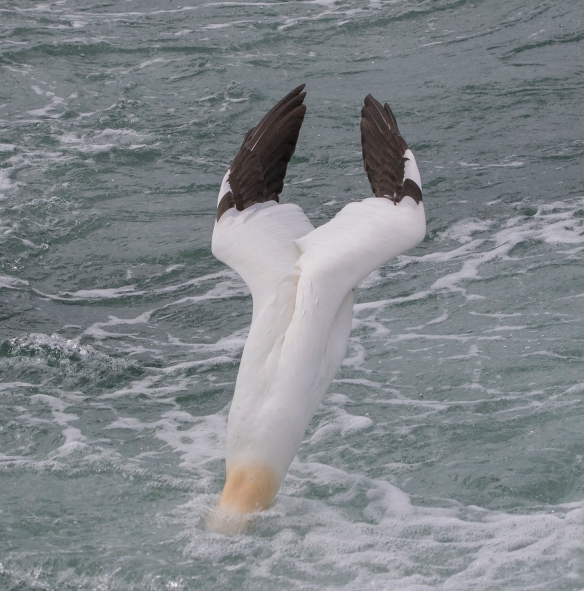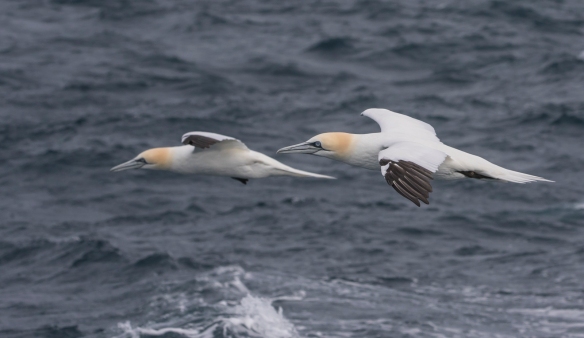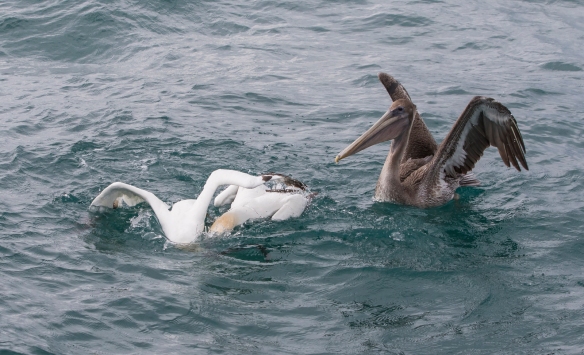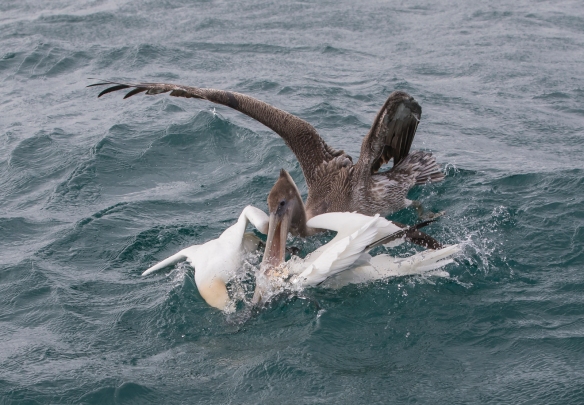Over the unlucky school of fish is a bewildering maze of soaring, circling birds, pouring down out of the sky in rapid succession, plunging into the water like so many projectiles and sending columns of water and spray many feet into the air like the spouting of a school of whales.
~Arthur Cleveland Bent, 1922, describing a flock of northern gannets feeding on a school of herring
Last Saturday was one of those days when it all seems to come together. I had a chance to really observe a species that I have wanted to see up close for a long time. What made it all possible was a pelagic birding trip aboard the Stormy Petrel II out of Hatteras. One of my goals for the trip was to observe northern gannets (Morus bassanus) up close and personal. For decades, I have seen them flying and diving off the beach. Over 30 years ago, while working as the East District Naturalist for NC State Parks, I found one dead on Hammocks Beach. I remember being stunned by the beauty and size of the bird I had previously only seen through binoculars. I have since watched them plunge-diving by the hundreds from places like Bald Head Island, and seen some flying nearby while offshore on various boats. But here was a chance, from what I had heard, to spend several hours watching them close to a boat while trying to photograph their flight and dives. I was not disappointed!
It didn’t take long for a couple of northern gannets to start following our boat as we passed through the inlet just after sunrise. As always, I was struck by their graceful, strong flight, and their striking head colors.
When you see a northern gannet adult from afar, you see a white cross with black wing tips. It is a distinctive shape – pointed at both ends with long, narrow wings. The Peterson Guide to Seawatching pointed out something that surprised me – northern gannets have a wingspan slightly shorter than that of a brown pelican, but longer than a tundra swan! That makes them the largest bird, other than a pelican, you are likely to see off our coast.
Of the hundreds of gannets seen, we only had two sightings of the darker-colored immature birds during the trip. Once they leave the nest, these young gannets are believed to stay at sea for at least 3 years before returning to land.
One interesting factoid that came up was that field studies the past couple of decades (largely by the late Dave Lee at the NC Museum of Natural Sciences, as reported in his book, Gulf Stream Chronicles) have revealed that almost all of the northern gannets wintering off the Carolina coast are adult males. This was determined by collecting and examining specimens, since the adult plumage of both sexes is basically identical. This has huge implications for conservation and management of this species. Since northern gannets off the Outer Banks in winter can number in the thousands, any ecological disaster in the area, such as an oil spill, could impact a disproportionately large percentage of the breeding population of this species. This is especially true since this species takes 4 to 6 years before reaching breeding age, and they typically lay only one egg per year.
One of the great highlights of the trip for me was being able to observe the gannets up close. It is only then that you can clearly see and appreciate the subtle colors of the adult bird’s head. The piercing eyes are lined with a light blue. The large, pointed bill is a blueish-gray color with black lines that outline it, the eye, and extend beyond the gape of the bill onto the neck. The head is tinged in a buff or gold color that varies among individual birds. Gannets have no external nostrils. Close inspection shows a slit-like opening near the base of the bill covered by a flap, which is forced shut over the opening when the bird plunges into the water.
The eyes look forward, presumably giving them good binocular vision, an important aid in accurately determining distances when diving after their prey.
Although believed to be generally silent at sea, many of the birds coming into the chum gave a grating, guttural croak as they maneuvered for position among the other birds.
Most of the gannets we observed were diving after the chum being tossed off the stern of the boat, but we did witness them feeding on something different at one point. We passed by two gannets huddled together, heads underwater. They were soon joined by a pelican, who soon stuck his beak into the action.
I couldn’t quite tell what was going on until one gannet gave up, and the other emerged victorious.
It turned out one of the gannets had caught a houndfish, a long, skinny member of the needlefish family.
The bird finally won the struggle with its writhing prey and gulped it down.
To catch their prey, northern gannets perform extraordinary plunge-dives from heights of as much as 100 feet above the ocean. From the shore, I have seen large flocks pelleting the ocean surface after fish in what one person has described as birds machine-gunning into the sea. These birds have special air sacs just under their skin, which one reference likened to bubble wrap under their feathers. This supposedly helps cushion the impact of the striking dives.

Wings folded back against body as the bird hits the water like a feathered spear thrown by the clouds
The anatomy of a typical low altitude dive is presented in the 4 photos above.
I mentioned in my last post that I took more photos on this trip than I ever have in any one day. Part of the reason is the fast frame rate of my camera (10 frames per second) coupled with my desire to capture a sequence of images of a northern gannet plunge dive. So, I took hundreds of images of these birds torpedoing into the water around the boat. Here are just a few more…




 I think my favorite is this last one, just before the moment of impact. I observed that many of the divers entered the water at a slight angle, rather than straight down, probably due to the low altitude from which they were spotting the chum, and the abundance of other birds in the air directly above the food. Northern gannets usually dive to relatively shallow depths (10 feet), but can, if needed, dive much deeper (75 feet or so).
I think my favorite is this last one, just before the moment of impact. I observed that many of the divers entered the water at a slight angle, rather than straight down, probably due to the low altitude from which they were spotting the chum, and the abundance of other birds in the air directly above the food. Northern gannets usually dive to relatively shallow depths (10 feet), but can, if needed, dive much deeper (75 feet or so).
When not plunging down like arrows shot into the water, the gannets often employed another type of shallow dive. They hover just above the water surface, touch down, and then stick their head and neck underwater.
Maybe they can’t help themselves and they just have to at least take a look underwater when they land on it.
As the afternoon continued, the gannets began to alternate between bouts of diving and brief spells of landing on the water. This is how they also often behave during migrations, slowly making their way from the breeding grounds in the far north to feeding areas along the east coast. Now that I have spent a day with the divers, I really want to travel north to see their breeding colonies. There are an estimated 60,000 breeding pairs on Bonaventure Island in Canada, one of the six main breeding sites for North Atlantic northern gannets. What a sight that must be! Until then, I will seek out time with these amazing arrows of the sea anytime I can get it.
























Very interesting and informative blog and marvelous photos!
Thanks, Maria.
What amazing energy in these gannets and in your photos!! Fascinating, Mike!!
Thanks, Mary Kay, and, yes, these birds are amazing.
Mike, this is fantastic!
Thanks, Rick.
PS Your hundreds of photos on the pelagic trip really paid off. ..These are just super….amazing……not that I’m telling you anything you don’t know….. Linda
Sent from my iPad
>
Thank you, Linda. It was great fun trying to capture the birds with my camera, especially the super fast dives of the gannets.
Wow! I’m so glad you stopped by my blog so I’d have the chance to return the visit. I think your love of northern gannets shows in your wonderful, sometimes breathtaking, images. I also enjoyed learning something about them.
Thanks, Robin. I have been reading your blog for quite some time now. You have a masterful combination of words and imagery.
loved the Gannets! great post.
Great blog and captures here! I initially noticed your “gannet eating dogfish” shots. So the bird really managed to beat the pelican and gulp that huge/formidable fish down?? Would the thrashing fish that size stand any slim chance of escaping or even damaging (I think the fish has needle like teeth as well,ah!) the birds stomach if eaten in that condition as well?!
Hard to imagine the big fish would surrender its whole life so easily to become just another meal to fill the birds belly!
Thanks, Kyle. The gannets had the fish first and the pelican tried to horn in (or beak in) on the action, but failed.
Oh interesting, I was curious can/how the bird really win its struggle with the huge fish I’m sure is disagreeing?!